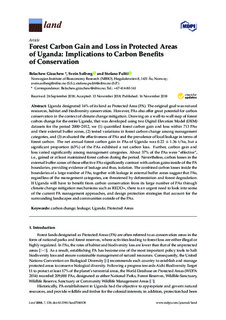| dc.description.abstract | Uganda designated 16% of its land as Protected Area (PA). The original goal was natural resources, habitat and biodiversity conservation. However, PAs also offer great potential for carbon conservation in the context of climate change mitigation. Drawing on a wall-to-wall map of forest carbon change for the entire Uganda, that was developed using two Digital Elevation Model (DEM) datasets for the period 2000–2012, we (1) quantified forest carbon gain and loss within 713 PAs and their external buffer zones, (2) tested variations in forest carbon change among management categories, and (3) evaluated the effectiveness of PAs and the prevalence of local leakage in terms of forest carbon. The net annual forest carbon gain in PAs of Uganda was 0.22 ± 1.36 t/ha, but a significant proportion (63%) of the PAs exhibited a net carbon loss. Further, carbon gain and loss varied significantly among management categories. About 37% of the PAs were “effective”, i.e., gained or at least maintained forest carbon during the period. Nevertheless, carbon losses in the external buffer zones of those effective PAs significantly contrast with carbon gains inside of the PA boundaries, providing evidence of leakage and thus, isolation. The combined carbon losses inside the boundaries of a large number of PAs, together with leakage in external buffer zones suggest that PAs, regardless of the management categories, are threatened by deforestation and forest degradation. If Uganda will have to benefit from carbon conservation from its large number of PAs through climate change mitigation mechanisms such as REDD+, there is an urgent need to look into some of the current PA management approaches, and design protection strategies that account for the surrounding landscapes and communities outside of the PAs. | nb_NO |

